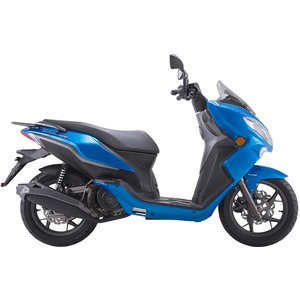Keeway Cityblade 125 (2015-2021) Review: Urban Agility Meets Practicality
Introduction
The Keeway Cityblade 125, produced from 2015 to 2021, represents a compelling entry into the urban scooter segment. Designed for practicality and ease of use, this model generation balances affordability with functional design. Over a week-long test ride, I explored its capabilities in city traffic, suburban roads, and even light highway stretches. Here’s how this scooter holds up in real-world conditions.
Design & Ergonomics
The Cityblade 125 adopts a clean, angular design language with sharp lines and a modern aesthetic. Its compact dimensions (1,950 mm long, 755 mm wide) make it ideal for weaving through traffic, while the 160 mm (6.3 inches) ground clearance handles curbs and potholes with surprising confidence. Color options evolved over the years, ranging from vibrant Light Blue to understated Black, giving riders room for personal expression.
The 760 mm (29.9-inch) seat height is a standout feature. Shorter riders will appreciate the flat, wide seat that allows both feet to plant firmly on the ground. Taller riders might find legroom slightly cramped, but the upright riding posture compensates with comfort during 30–60-minute commutes.
Practicality shines with under-seat storage large enough for a full-face helmet or groceries. The analog-digital instrument cluster is basic but legible, featuring a speedometer, odometer, and fuel gauge. Fit-and-finish varies slightly between model years, with later E4 variants (2019–2021) showing improved panel gaps and switchgear quality.
Engine & Performance
At its core lies a 125cc air-cooled single-cylinder engine. Early models (2015–2017) used a carburetor, delivering 9 HP at 7,500 RPM, while later E4 versions (2019–2021) switched to fuel injection for smoother throttle response. The 9.2 Nm (6.8 lb-ft) torque peak at 6,500 RPM feels punchy off the line, propelling the 123 kg (271 lbs) scooter to 0–50 km/h (0–31 mph) in 6.5 seconds. Top speed settles around 90 km/h (56 mph), though maintaining 80 km/h (50 mph) on highways requires patience.
The CVT transmission is seamless in urban settings. Accelerating from traffic lights feels effortless, and the belt-driven system eliminates chain maintenance hassles. Fuel efficiency impresses at 2.5–2.8 L/100 km (94–84 mpg), translating to a 220–250 km (137–155 mi) range from its 6–7 L (1.6–1.85 gal) tank.
Handling & Ride Quality
Keeway opted for a telescopic front fork and rear telescopic units (or single damper on pre-2018 models). Suspension travel—89 mm (3.5 inches) front / 69 mm (2.7 inches) rear—absorbs minor road imperfections adequately, though sharper bumps can feel harsh. The 14-inch wheels provide stability over patchy surfaces, and the MRF tires (90/90-14 front, 100/90-14 rear) offer decent grip in dry conditions.
At low speeds, the Cityblade feels nimble, with a tight 1,330 mm (52.4-inch) wheelbase enabling U-turns in just 2.5 lanes. At higher speeds, crosswinds may induce slight wobbles due to the lightweight chassis. Braking is predictable, with single discs front and rear offering adequate stopping power. ABS isn’t available, so wet-weather riding demands caution.
Comfort & Daily Usability
The Cityblade excels as a daily workhorse. The wide floorboard accommodates larger items like backpacks, and the optional top case (sold separately) enhances cargo capacity. Wind protection is minimal, making sustained 70+ km/h (43+ mph) rides fatiguing over long distances.
Vibration levels are well-controlled below 6,000 RPM, though the air-cooled engine buzzes noticeably at full throttle. The 6.3-inch ground clearance allows confident mounting of sidewalks, while the center stand engages with minimal effort—a boon for quick parking.
Competition
The 125cc scooter market is fiercely competitive. Here’s how the Cityblade stacks up:
- Honda PCX 125: More refined, liquid-cooled engine, but 30% pricier. Lacks the Cityblade’s simplicity for easy repairs.
- Yamaha NMAX 155: Higher power (15 HP) and ABS, but heavier and less fuel-efficient.
- Kymco Agility 125R: Comparable specs, but Kymco’s dealer network is spottier in Europe.
The Cityblade’s edge lies in its straightforward mechanics and lower ownership costs. While it lacks premium features like idle start-stop or smartphone connectivity, its no-nonsense approach appeals to budget-conscious commuters.
Maintenance
Ownership costs are where the Cityblade truly shines. The air-cooled engine avoids complex cooling systems, and the belt-driven CVT requires only periodic inspections. Key maintenance tips:
- Oil Changes: Use 10W-40 JASO MA2 oil every 3,000 km (1,864 mi). Later fuel-injected models benefit from synthetic blends.
- Belt Replacement: Inspect the CVT belt every 15,000 km (9,320 mi). Consider upgrading to a reinforced aftermarket belt for heavier loads.
- Valve Adjustments: Check every 6,000 km (3,728 mi). The SOHC design simplifies this 30-minute job.
- Brake Care: Replace DOT 4 fluid annually. Swap stock pads for sintered variants if riding in hilly areas.
Common wear items like tires, brake pads, and bulbs are widely available at MOTOPARTS.store. For enhanced longevity, consider installing a stainless steel exhaust header (stock is mild steel) and upgrading to a high-flow air filter.
Final Thoughts
The Keeway Cityblade 125 isn’t about cutting-edge tech or adrenaline-pumping performance. It’s a pragmatic tool for urban survival—affordable to buy, cheap to run, and forgiving for novice riders. While rivals offer more polish, few match its balance of simplicity and capability. For city dwellers seeking reliable transportation without frills, this scooter remains a compelling choice.
Ready to personalize your Cityblade? Explore MOTOPARTS.store’s range of ergonomic seats, windshields, and performance upgrades to tailor this scooter to your needs.

















